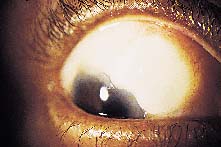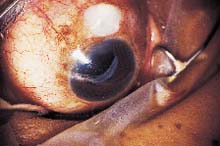Bleb failures can be easily handled, if caught early
Surgeons are advised to look for the warning signs. A variety of methods could save the bleb.
GRAND CAYMAN, British West Indies — Early bleb failures can often be handled easily, as long as the surgeon looks for the warning signs.
According to Irvin P. Pollack, MD, “It’s well known that glaucoma medications can predispose to bleb failure, and cumulative antiglaucoma treatments are responsible for conjunctival inflammatory infiltrates in the bleb and cause episcleral fibrosis.”
Blebs can fail because the internal ostium is blocked by the iris, a membrane or fibrin and vitreous.
Episcleral fibrosis can cause closure of the flap margins lining the bleb and can cause an encapsulation. Collagen within the bleb occurs in 10% to 14% of cases.
“The problem is how to manage these blebs,” Dr. Pollack said. “In most cases, you can leave them alone. You can just simply control the elevated intraocular pressure [IOP] with anti-glaucoma medication, particularly aqueous suppressants, and the bleb will gradually resume functioning in most cases.”
For the remainder, a variety of methods can cure the problems, said Dr. Pollack, who spoke at the Winter Glaucoma Symposium about dysfunctional blebs and their repair.
Overhanging blebs
 ---A
large bleb shown preoperatively.
---A
large bleb shown preoperatively.
The ideal bleb is ischemic, cystic, moderately elevated and has a moderately thin wall. IOP stays between 6 mm Hg and 12 mm Hg. The patient remains comfortable, has no pain and the bleb remains hidden beneath the upper eyelid.
However, blebs can be painful, oversized or hang over the cornea.
“The painful bleb is the one that often concerns us the most, and yet it’s probably the least problematic,” Dr. Pollack said.
Dellen can cause these symptoms. The dellen typically occurs anterior to the bleb. The tear film is kept from reaching the bleb edge by the bleb itself. The tear film bridges the dellen and leaves it dry. This dry area causes persistent, continuous pain that is disturbing to the patient.
A patient also may notice the dellen by the “snapping bubble sign.” The tear film leaves a bubble between the cornea and the bleb. With each blink, the bubble breaks and the patient feels it. Every time the patient blinks, he or she feels pain.
One can treat this conservatively with artificial tears or ointment. But if it does not go away, then the surgeon may need to reduce the bleb size.
An overhanging bleb is unsightly. In most cases, it is relatively small and requires only observation. The patient may not complain about it, or it may regress with time.
Those that require treatment can be treated by lifting them up with conjunctival forceps and then cutting across the free edge of the bleb where it crosses the limbus.
“If you’re really concerned that there may be a leak at the excised edge, you can place a ligature around the bleb at the limbus and excise the distal end of the bleb,” Dr. Pollack said.
Handling hypotony
 ---Fluorescein photo shows bleb leakage.
---Fluorescein photo shows bleb leakage.
Hypotony following trabeculectomy is one of the greatest risks. It can stem from hyposecretion after the procedure itself. But in other cases, it may be due to excessive filtration from a buttonhole or a bleb leak.
In hypotony, a breakdown in the blood ocular barrier occurs, with leaks of protein into the superchoroidal space. This protein sucks up aqueous from the vitreous, causing a choroidal effusion. The choroidal effusion further aggravates the hypotony, Dr. Pollack said.
“Our concerns are mostly with the bleb that has excess filtration,” he said. “They’re sometimes associated with choroidal effusion, but generally the choroidal effusion is not a major problem.”
Conservative management of the overfiltering bleb includes hyposecretory agents that minimize the amount of aqueous going through the trabeculectomy site.
Cryosurgery is another effective method. Surgeons can set the unit to –80°F and apply it for 30 seconds to the bleb. The probe is defrosted and lifted. This excites enough inflammation to decrease the size of the bleb.
Intrableb injection of autologous blood has become very popular. However, overfiltering eyes have a large opening, causing the draining. Blood in the bleb may enter the anterior chamber. “There is nothing worse than having an unhappy patient because he or she suddenly lost what vision he or she had after you’ve done this procedure,” Dr. Pollack said. The blood will generally reabsorb and not cause problems afterward.
Some surgeons have used Nd:YAG laser to focus through the bleb onto an episcleral vessel. This breaks the vessel and delivers autologous blood into the bleb. Still, there is the chance that that blood may go into the anterior chamber. It is more likely that this procedure will produce too little bleeding to be effective, Dr. Pollack said.
Argon lasers are often ineffective when used to treat the bleb surface in order to excite inflammation. This may be because blebs are often ischemic and do not absorb the energy. Some surgeons have suggested defocusing the beam into an episcleral region where the blood vessels will absorb the energy. Others coat the bleb surface with rose bengal.
Blebitis
 ---Bleb
as it appears just before Palmberg suture.
---Bleb
as it appears just before Palmberg suture.
The use of antimetabolites has led to an increase in bleb infections. The ischemic, thin filtering bleb triggered by their use is predisposed toward bleb infections.
These cases present with marked, intense peribulbar conjunctival congestion. The eye is red with a white, opalescent ischemic bleb. They often have a hole, and if they have a positive Seidel test, there may be anterior chamber reaction. The typical organism is Staphylococcus epidermidis or Staphylococcus aureus. Treatment includes frequent instillation of topical ofloxacin and bacitracin, sometimes combined with oral ofloxacin.
Often, blebitis can be cleared without any endophthalmitis developing. If it does occur, patients’ vision rapidly worsens. They get marked redness, pain and conjunctival congestion. Fibrin appears in the anterior chamber and hypopyon occurs. The etiology is often Streptococcus rather than Staphylococcus, and the prognosis is poor.
For Your Information:
- Irvin P. Pollack, MD, can be reached at Sinai Hospital, 2411 Belvedere Ave., Baltimore, MD 21215-5271 U.S.A.; +(1) 410-601-5900; fax: +(1) 410-601-6284.
